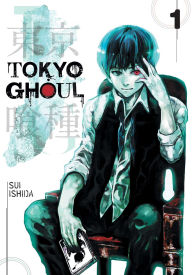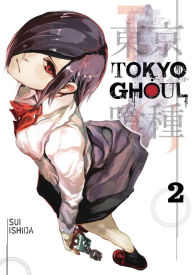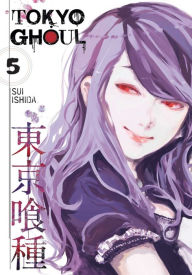Some Ghouls: Why We Love Tokyo Ghoul
Tokyo Ghoul, Vol. 1
Tokyo Ghoul, Vol. 1
By Sui Ishida
In Stock Online
Paperback $14.99
Tokyo Ghoul has a lot in common with Attack on Titan: a compelling, twisty story; a great cast of characters; and a malevolent, looming evil we learn more about as the series goes on. The ghouls of Tokyo Ghoul look human, but they are really a different species that must eat human flesh to survive. Creator Sui Ishida delivers plenty of action, but he mixes in real drama as the characters on both sides confront the evil that walks among them—and the enemy within.
We love the series, and we’re confident you will too. If you haven’t started reading yet, it’s the perfect time to jump in. Joel Enos, who edits the series, recently dropped some big news at the Viz Media panel at C2E2: “The first five volumes, and into the sixth, are sort of dealing with Ken finding his personal way into the story,” he said. “As we get into volumes 7 and 8, we see more of the impact of the wider world and what that means—having the ghoul world and human world fit together. So there’s almost this big global shift coming in the manga.”
Here’s a look at what Tokyo Ghoul is about—and why you should check it out.
Tokyo Ghoul has a lot in common with Attack on Titan: a compelling, twisty story; a great cast of characters; and a malevolent, looming evil we learn more about as the series goes on. The ghouls of Tokyo Ghoul look human, but they are really a different species that must eat human flesh to survive. Creator Sui Ishida delivers plenty of action, but he mixes in real drama as the characters on both sides confront the evil that walks among them—and the enemy within.
We love the series, and we’re confident you will too. If you haven’t started reading yet, it’s the perfect time to jump in. Joel Enos, who edits the series, recently dropped some big news at the Viz Media panel at C2E2: “The first five volumes, and into the sixth, are sort of dealing with Ken finding his personal way into the story,” he said. “As we get into volumes 7 and 8, we see more of the impact of the wider world and what that means—having the ghoul world and human world fit together. So there’s almost this big global shift coming in the manga.”
Here’s a look at what Tokyo Ghoul is about—and why you should check it out.
Tokyo Ghoul, Vol. 2
Tokyo Ghoul, Vol. 2
By Sui Ishida
In Stock Online
Paperback $14.99
Paradoxical Predators: Although they usually appear human, ghouls are a different species, and in order to survive they must eat human flesh—all other foods are repulsive to them. (Except coffee—we’ll get to the coffee in a minute.) They mingle with their prey, blending in most of the time—until they corner someone for the kill. Ghouls wear clothes, go to work and school, even pretend to eat regular food, but they are detached from humanity, regarding us as livestock. They have a whole social structure of their own, and some try to cross over, living alongside humans and learning their ways. The riddle of how hunter and prey can peacefully coexist is a major theme, and some of Ishida’s answers are surprising.
Ken Kaneki: Mild-mannered college student Ken is the lead character. When we first meet him, he’s nerdy and nice—he has a taste for literary novels, and he likes hanging out in cafes with his boisterous friend Hide. He also has a crush on a girl who likes the same author he does, but he’s too shy to say anything. Ken’s world is turned upside down when a doctor transplants a ghoul’s organs into his body after an accident, an operation that saves his life but also leaves him half-human, half-ghoul. Suddenly he can’t eat any normal food, but he soon becomes ravenously hungry—and he is horrified to learn that the only way to quell his growing hunger is to eat other humans.
Paradoxical Predators: Although they usually appear human, ghouls are a different species, and in order to survive they must eat human flesh—all other foods are repulsive to them. (Except coffee—we’ll get to the coffee in a minute.) They mingle with their prey, blending in most of the time—until they corner someone for the kill. Ghouls wear clothes, go to work and school, even pretend to eat regular food, but they are detached from humanity, regarding us as livestock. They have a whole social structure of their own, and some try to cross over, living alongside humans and learning their ways. The riddle of how hunter and prey can peacefully coexist is a major theme, and some of Ishida’s answers are surprising.
Ken Kaneki: Mild-mannered college student Ken is the lead character. When we first meet him, he’s nerdy and nice—he has a taste for literary novels, and he likes hanging out in cafes with his boisterous friend Hide. He also has a crush on a girl who likes the same author he does, but he’s too shy to say anything. Ken’s world is turned upside down when a doctor transplants a ghoul’s organs into his body after an accident, an operation that saves his life but also leaves him half-human, half-ghoul. Suddenly he can’t eat any normal food, but he soon becomes ravenously hungry—and he is horrified to learn that the only way to quell his growing hunger is to eat other humans.
Tokyo Ghoul, Vol. 3
Tokyo Ghoul, Vol. 3
By Sui Ishida
In Stock Online
Paperback $14.99
A Clean, Well Lit Place: Unrelenting horror can be exhausting. One of the things Tokyo Ghoul does really well is alternate between ghoul attacks in dark alleys and quieter scenes set in safe spaces. In this series, the safe space is Anteiku, a coffeehouse run by ghouls and catering to both humans and ghouls. This is where this story becomes more than a supernatural battle manga: it turns out that some ghouls want to find common ground with humans. Since coffee is the one human food they can tolerate, a coffeehouse is a perfect setting for them to meet and study humans (who have no idea the staff is all ghouls), and the slice-of-life scenes in the cafe not only modulate the pace of the story but provide opportunities for the characters to talk about what’s going on.
A Clean, Well Lit Place: Unrelenting horror can be exhausting. One of the things Tokyo Ghoul does really well is alternate between ghoul attacks in dark alleys and quieter scenes set in safe spaces. In this series, the safe space is Anteiku, a coffeehouse run by ghouls and catering to both humans and ghouls. This is where this story becomes more than a supernatural battle manga: it turns out that some ghouls want to find common ground with humans. Since coffee is the one human food they can tolerate, a coffeehouse is a perfect setting for them to meet and study humans (who have no idea the staff is all ghouls), and the slice-of-life scenes in the cafe not only modulate the pace of the story but provide opportunities for the characters to talk about what’s going on.
Tokyo Ghoul, Vol. 4
Tokyo Ghoul, Vol. 4
By Sui Ishida
In Stock Online
Paperback $12.99
Predators and Prey: Battles are a big part of this sort of manga, although sometimes the action is hard to follow. The ghouls fight with special organs called kagune, and volume 6 includes a lecture on ghoul biology that explains how they work. While ghouls prey on humans, they also have an enemy: The Commission of Counter Ghoul (CCG), whose agents, known as doves, investigate ghoul attacks and often capture and kill ghouls, taking their kagune to make their own weapons, called quinques. This results in some spectacular fights, when one set of superpowered weapons goes up against another. It also shows the other side of the coin, as some of the doves take sadistic pleasure in murdering the ghouls.
Predators and Prey: Battles are a big part of this sort of manga, although sometimes the action is hard to follow. The ghouls fight with special organs called kagune, and volume 6 includes a lecture on ghoul biology that explains how they work. While ghouls prey on humans, they also have an enemy: The Commission of Counter Ghoul (CCG), whose agents, known as doves, investigate ghoul attacks and often capture and kill ghouls, taking their kagune to make their own weapons, called quinques. This results in some spectacular fights, when one set of superpowered weapons goes up against another. It also shows the other side of the coin, as some of the doves take sadistic pleasure in murdering the ghouls.
Tokyo Ghoul, Vol. 5
Tokyo Ghoul, Vol. 5
By Sui Ishida
In Stock Online
Paperback $14.99
Side Characters: Tokyo Ghoul has a great ensemble cast. Like Attack on Titan, it features an ass-kicking female second lead—in this case, it’s Touka, a ghoul who works at the café. She’s cold-blooded when it comes to the necessity of killing humans, but she also goes to a human school and has a human friend. Yomo, a big guy with a hipster goatee, is the guy who gets things done—among other things, he fetches the ethically sourced meat served to the ghouls at Anteiku. Mr. Yoshimura, the manager, is a mysterious older man who seems to be trying to find a middle road for ghouls. The ghouls, doves, and humans that fill these pages aren’t just cardboard-cutout heroes and villains—they all have flaws and quirks and often a surprising ambivalence.
Great Storytelling: Like many manga, Tokyo Ghoul features a lead character who is suddenly thrust into an unfamiliar and dangerous world. One of the most annoying tendencies of stories like this is for the other characters to deliberately withhold information about this new world for no reason. Ishida avoids this trap, bringing in each element of Ken’s new life as necessary.
Side Characters: Tokyo Ghoul has a great ensemble cast. Like Attack on Titan, it features an ass-kicking female second lead—in this case, it’s Touka, a ghoul who works at the café. She’s cold-blooded when it comes to the necessity of killing humans, but she also goes to a human school and has a human friend. Yomo, a big guy with a hipster goatee, is the guy who gets things done—among other things, he fetches the ethically sourced meat served to the ghouls at Anteiku. Mr. Yoshimura, the manager, is a mysterious older man who seems to be trying to find a middle road for ghouls. The ghouls, doves, and humans that fill these pages aren’t just cardboard-cutout heroes and villains—they all have flaws and quirks and often a surprising ambivalence.
Great Storytelling: Like many manga, Tokyo Ghoul features a lead character who is suddenly thrust into an unfamiliar and dangerous world. One of the most annoying tendencies of stories like this is for the other characters to deliberately withhold information about this new world for no reason. Ishida avoids this trap, bringing in each element of Ken’s new life as necessary.
Tokyo Ghoul, Vol. 6
Tokyo Ghoul, Vol. 6
By Sui Ishida
In Stock Online
Paperback $12.99
If something new is mentioned, the other characters may roll their eyes and refuse to explain, but all will be made clear in a few pages. He also keeps things moving, with new characters, twists, and story elements coming along just as the reader gets comfortable with the status quo. Small but telling details often help the story along—for example, one character wears glasses, and we never see his eyes until the moment that true emotion breaks through.
At another point, when Ken opens his bag to get his grotesque leather ghoul mask before going into battle, there’s a literary novel next to it, showing the gentler side of his personality. Ishida makes judicious use of foreshadowing, and certain threads run through the narrative, such as the ghoul expert who pops up in several different volumes, pontificating on TV about something he doesn’t really understand. In a book with a lot of oversize characters and battles, Ishida makes full use of the small moments as well.
Curious? Check out a free preview of the manga on Nook! And if you prefer to read and watch, the Tokyo Ghoul anime is available on Bluray.
If something new is mentioned, the other characters may roll their eyes and refuse to explain, but all will be made clear in a few pages. He also keeps things moving, with new characters, twists, and story elements coming along just as the reader gets comfortable with the status quo. Small but telling details often help the story along—for example, one character wears glasses, and we never see his eyes until the moment that true emotion breaks through.
At another point, when Ken opens his bag to get his grotesque leather ghoul mask before going into battle, there’s a literary novel next to it, showing the gentler side of his personality. Ishida makes judicious use of foreshadowing, and certain threads run through the narrative, such as the ghoul expert who pops up in several different volumes, pontificating on TV about something he doesn’t really understand. In a book with a lot of oversize characters and battles, Ishida makes full use of the small moments as well.
Curious? Check out a free preview of the manga on Nook! And if you prefer to read and watch, the Tokyo Ghoul anime is available on Bluray.





